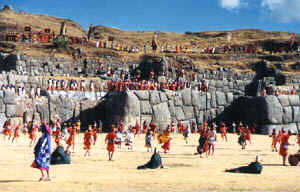Text and photos by Robert Scheer

Sacsayhuaman is located only 2 kilometers from Cusco, and the distance can be walked in about 45-minutes, although the climb is steep, and at an altitude of 3500 meters (more than 10,000 feet above sea level), it can be strenuous, so you’re best to go by taxi or tourist bus. There is an admission charge, and if you are not traveling as part of an organized group, you should remember to get a Cusco Tourist Ticket first at the Galeria Turistica office in Cusco. This ticket costs about $10, and is good for admission to the Korikancha, Cusco Cathedral, Quenko, Tambo Machay, Pisac, Ollantaytambo and several other attractions besides Sacsayhuaman.